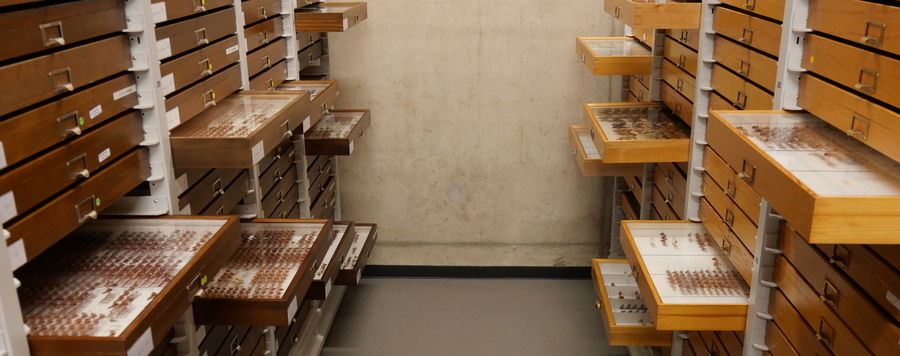
Clas Naumann Zygaenidae collection
The Zygaenidae family (Lepidoptera) was the special group of Prof. Dr. Clas M. Naumann, the long-time director of the ZFMK (1989-2004). He dedicated his life to the research of this diurnal lepidopteran family, in particular the genus Zygaena itself. As a basis for his scientific work, he assembled a unique collection over the course of more than four decades, which was certainly the most important private collection of this attractive butterfly family. It is of a rare completeness, only a few taxa are missing, and is rich in type specimens.According to his will the collection was transferred to the Koenig Museum in June 2004.
The collection comprises around 100,000 prepared specimens, housed in over 400 insect drawers, supplemented by an extensive collection of duplicates. C. M. Naumann collected "his" zygaenids on countless journeys abroad, mostly trying to find very specific, little known species with unexplored biology. Long lost species aroused his special interest. Often an entire expedition was dedicated to a single species and he usually succeeded in finding it for the first time after years or decades. It did not satisfy him, however, to catch specimens of these rare species for his collection, but his main attention was always directed to the clarification of the mostly still completely unknown life history of these animals. The food-plant of the caterpillars was determined in the terrain through observation of egg-laying females, the hatching caterpillars were reared with considerable effort. The collection bears witness to this in the countless biological specimens, such as pupal cocoons, which were pinned and extensively labelled just like the Lepidotera specimens themselves. There are also over 20 drawers of parasitoids hatching from caterpillars collected in the field, a valuable resource for Hymenoptera and tachinid fly specialists. Securing the exact locality data was always an important concern and was done by C. M. Naumann with great care. All specimens in the collection are provided with detailed, printed locality labels. Of course, Zygaenid specimens and rearing were also documented photographically, and pictures and breeding results were processed in numerous publications. During his travels to Morocco, Turkey, Iran and many other countries, but above all during his three-year stay in Afghanistan, C. M. Naumann discovered a multitude of new subspecies and also some new species, which he described in over one hundred scientific papers. The type specimens he defined are mainly in his collection: 32 holotypes and about 5400 paratypes of new species and subspecies. Further type material came into the collection by exchange or purchase, many famous names of older authors and contemporary zygaenid specialists adorn the recently completed type catalogue: Burgeff, Sheljuzhko, Reiss, Koch, Holik, Alberti, Wiegel, Tremewan and others, even paratypes of "classical" authors such as Boisduval, Herrich-Schäffer, Mabille, Oberthür, Poujade, Rothschild and Staudinger can be found, further evidence of the outstanding scientific value of the Zygaenidae collection Clas M. Naumann.
Special features of the Naumann collection:
Zygaena (Mesembrynus) halima Naumann, 1977, from Afghanistan. Holotype and only known specimen worldwide.
Zygaena (Agrumenia) pamira shugnana Naumann 1978, Paratype. The "highest zygaenid of the world" lives in over 4000m elevation in the Central Asian mountains.
Zygaena (Z.) problematica Naumann, 1966, Paratype. The first zygaenid species described by C. M. Naumann, from southern Turkey.
Zygaena (Agrumenia) storaiae Naumann 1974, Paratype. C. M. Naumann named this species from Afghanistan after his wife, Dr. Storai Naumann-Nawabi.






